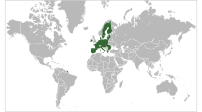[print_link]
First, we'll go through the course outline in some detail. Housekeeping over, we'll head straight into talking about the economics of European Integration. Click below for lecture notes, the handout, and the slides for the first lecture.
0. Definition
Economic integration can be defined as the elimination of barriers to the movement of products and factors of production between a group of countries and the introduction of common policies.
Jan Tinbergen (1954) created the distinction between negative integration---the removal of barriers---and positive integration---the introduction of common policies, and building of common institutions.
Be careful though---this distinction is only relevant when a state’s intervention is limited to measures taken at the border, such as tariffs, import quotas, etc. So there are complications to consider. EC4333 is essentially about those complications.
Stages of Integration
Balassa (1961) defines the stages of economic integration as a linear process. The problem is the history of this process is not a straight line, at least on many axes.
1. Free trade areas (FTAs)
FTAs occur when member states remove all barriers on trade between themselves, but retain the freedom to implement different commercial policies towards third countries.
In order to get around the problem of importing for re-exporting, free trade areas require rules of origin. In other words, when a good is traded it has to be accompanied by documentation stating where it was made. Rules of origin may be complex to administer, and the regulatory uncertainty to which they give rise means that market access is conditional. Examples of FTAs are the EFTA, the EEC, and NAFTA. Click the links for more information.
2. Customs unions
The member states remove all barriers on trade between themselves and introduce a common external commercial policy (for instance a common external tariff ) towards the rest of the world.
An example of a customs union is that between the EU and Turkey which came into operation from 1995 but which largely excluded agricultural products.
3. Common markets
These are customs unions, which also allow for free factor mobility. In other words, a common market entails the so-called four freedoms: freedom of movement of goods, services, labour and capital. During the early years the Community was sometimes called the ‘common market’, although this description was not very accurate as the then EEC was more like a customs union with certain sectoral policies (notably the Common Agricultural Policy) financed largely through a Community budget.
4. Economic and monetary union
An economic and monetary union should include: a common market; co-ordination or central control of monetary and fiscal policies; a common money or complete convertibility among national currencies with no possibility of exchange-rate adjustments; and a common authority which acts as a central bank, the ECB.
5. Political union
There is no accepted definition of political union. Political union involves a central authority that has supranational powers similar to those of a nation’s government over various policy areas including, for example, foreign policy and security matters, and is responsible to a directly elected central parliament. The current debate over the Lisbon Treaty essentially delimits the range of political union the EU might achieve, and we'll talk about Lisbon in the next lecture.
Slides
Handout
Right click to download the handout.
ec4333_lecture1_handout_numbers
Reading for next lecture:
Beach, D., The Dynamics of European Integration, pgs. 1–31, and pgs. 214–244, 337.142 BEA.
Related articles
- EC4333, Economics of European Integration, Module Outline 2008
- European economic integration and trade: how big was the boost?
- Regional monetary integration
- James Zogby: The Irish Vote "No" on Lisbon


